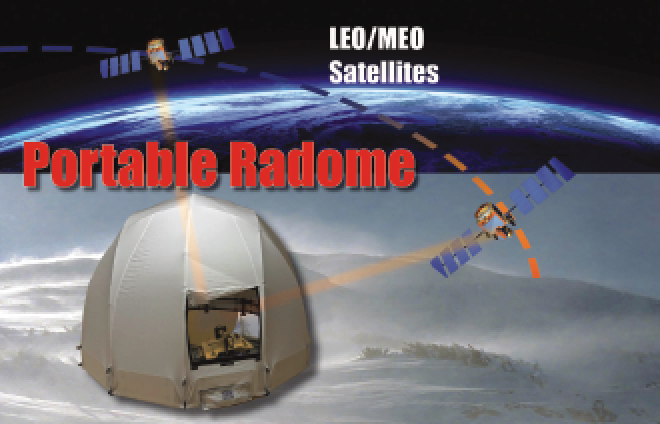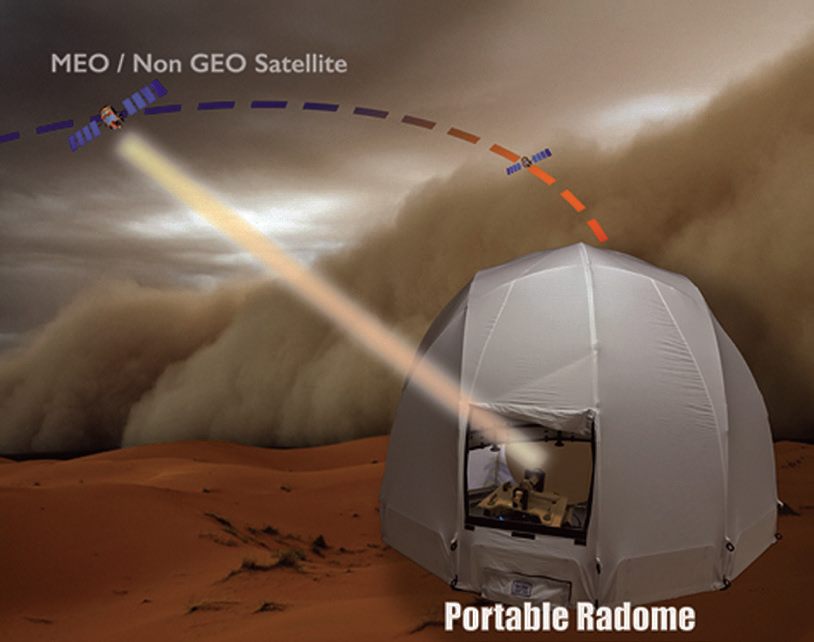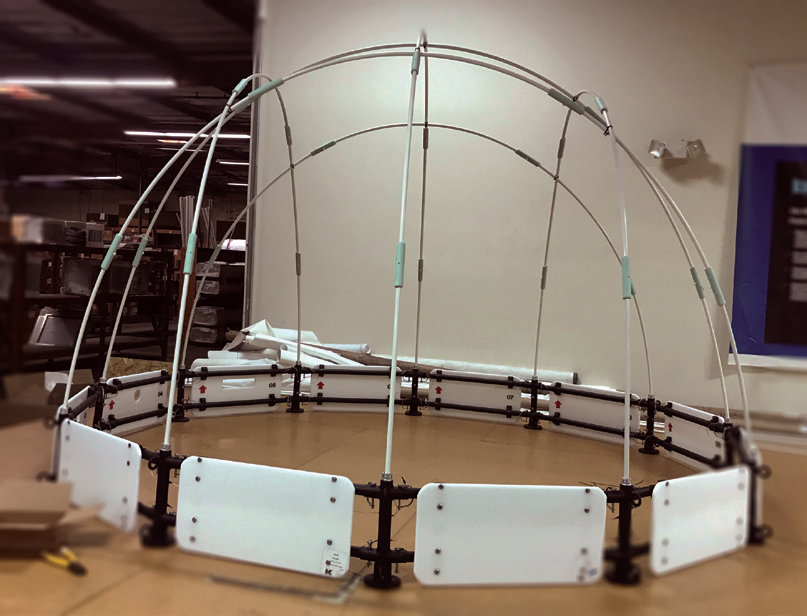Battlefield tactical teams, mobile command posts and special operations units can have requirements for high bandwidth SATCOMS and use vehicle-mounted, VSAT, and handheld systems that need to be available in remote and harsh environments. These kinds of land SATCOM terminals can be subject to extreme weather conditions including snow, heavy rain and moisture, ice, wind and sandstorms, and intense heat.

Traditional Radomes
All-weather operations pose unique challenges in deployment of portable SATCOM terminals. For example, high winds can make it difficult to maintain antenna reflector pointing on the satellite, causing signal outages or interference. Snow and ice accumulation on antennas can cause signal problems and outages.
In sandstorms, antennas, feeds, auto-track drive systems and reflectors must be protected from dust and sand that can cause equipment malfunction or damage. In snowstorm, windstorm, rainstorm, and similar conditions, antenna feeds and reflectors must be protected from snow, ice, rain and winds.
Traditionally, radomes have been used to provide satellite earth station antenna protection from extreme elements. Another benefit is they can prevent hostile air or space reconnaissance forces from viewing the equipment underneath a radome. However, traditional antenna radomes are not built for easy transport.
Transport and Rapid Deployment Challenges
The deployment of transportable SATCOM terminals into far-flung environments for land-based communications creates a new need for equally transportable radome solutions. Many of today’s military and first-responder, applications on land require deployable systems where harsh elements demand radome-like protection.
Examples employed by the U.S. military include:
• Portable Fixed Satellite Services/VSAT terminals, which can range from .45-meter man-packable systems to nearly 4-meter systems capable of rapid high-bandwidth service activation and use of DISC, WGS, and commercial satellite services
• Flyaway and transportable terminals of this type in the 0.5 to 2.5-meter reflector range
• The U.S. DOD has also invested in network services that leverage the low-latency, high-throughput MEO 03b commercial satellite constellation for applications. Several terminal manufacturers are supplying the antenna subsystems for terminals to operate on the 03b system. For example, transportable 03b terminal packages offered to U.S. DOD buyers include antennas from General Dynamics, AVL, from .85 to 2.4 meters in size.
The Portable Radome
The Walton Portable Radome is a new solution for protecting deployable SATCOMS terminals from the elements. The Walton Portable Radome unleashes a whole new set of possibilities for operating Satellite Transportable Terminals (STT) and micro-VSATs in extreme and mobile conditions. This can support military requirements for high capacity data, voice and video capabilities worldwide. It provides a uniquely deployable weather protection solution for applications such as:
• Military vehicular mount terminals “drive-aways”
• Comms-on-the-Pause (COTP) SATCOM antennas
• VSATs
• Enterprise terminal antennas, and MEO field terminals, and LEO feeder/gateway antennas
The lightweight, rapidly deployable solution protects antennas from rain, snow, ice, wind, sand, debris and heat. The Portable Radome helps make satellite networks more survivable and deployable into extreme or harsh environments, including windstorms, sandstorms, dust storms, blizzards, hail, torrential rains and burning heat and sun.

Artistic rendition of a Walton Portable Radome facing a
sandstorm. Image is courtesy of the company.
It also offers cost savings and other advantages compared to traditional Radomes. It can keep away ice and snow, and battle the effects of rainwater accumulation, and heavy winds. In the burning desert sun, the Portable Radome can keep antenna reflectors and outdoor electronic equipment cool — to prevent damage.
RF Transparency
The Walton Portable Radome employs rugged, RF-transparent, hydrophobic antenna cover materials, and materials similar to those used in Walton De-Ice’s field proven Snow Shield and Ice Quake systems deployed around the globe to protect earth station antennas from snow, ice, rain, and sun.
For example, field testing performed by performed by ACTIA Telecom Group, France has shown a minimal G/T decrease of only 0.31 dB at 20 GHz when the Portable Radome covers a .98-meter Skyware Global Ka Band terminal type used by the Ministry of Defense of France.
Protecting SATCOM Tactical Assets
The Portable Radome can protect SATCOM terminals from disabling damage and loss-of-use due to temporary environmental hazards in the field – preventing loss of critical communications links. It can provide an “extra-ruggedness insurance policy” for the VSAT equipment when there is no way that a repair/replacement part could be fielded in time for a mission.
Highly ruggedized antenna terminals can be costly. Spares and repairs are not cheap. Transportable SATCOMs terminal acquisition costs can be in excess of $230,000 to $300,000 for some ruggedized MEO configurations, depending on the unit. By protecting field deployable terminals from environmental damage, the Portable Radome can extend the life of SATCOM terminal assets and equipment, reduce mean-time-to-repair, reduce fleet maintenance costs, and help reduce replacement costs. This can free organizations’ budget dollars to spend on other items.
Portable Radome Benefits
Wind Resistance
Operational in an 85 mph (136 kph) constant wind load, the self-supporting structure requires no continuous power, unlike Inflatable SATCOM Antennas (ISA) antenna covers. A Portable Radome can operate at twice the wind load of some popular inflatable systems at sizes suitable for field deployable terminals. But unlike inflatable antenna covers that require a continuously powered blower to stay inflated, the Portable Radome structure is self-supporting.

Walton LEO / MEO dome structure for the Portable Radome.
Photo is courtesy of the company.
Deploys Easily to Harsh Terrain/Remote Sites
For many remote and deployed sites — installation with a crane is cost-prohibitive. For some sites, crane installation is simply not an option, but the Portable Radome can easily do the job, in effect “going where no radome has gone before.”
Multi-Band
The Walton Portable Radome (available for C, Ku, X, or Ka-Band) also enables operators to gain significant cost saving vs. conventional radomes for military networks. Radome sizes range from 1.5 to 9.1 meters in diameter, and from 1 meter to 7.6 meters in height. They can protect Parabolic antenna reflectors in a variety of sizes.
Heating and Cooling
In extremely hot environments, such as burning desert sun, an efficient Air Conditioning Unit can be added in order to cool temperatures underneath the Radome – and prevent over-heating damage to equipment under the dome. For snowy and icy environments, various Walton Electric Heater configurations to perform De-Icing functions for the Portable Radome. Automatic De-Icing conserves energy. Other functions that can be remotely controlled and monitored include snow detection and precipitation sensing.
Speedy Setup
A single person can quickly and easily assemble the lightweight, rapidly deployable Portable Radome, with no tools.
Light and Airline Checkable
The small flyaway lightweight model (2.13m x 1.68m / 44.45 kg.) is airline baggage checkable. And yet, for all these benefits, it can also support permanent site requirements.
LEO and MEO Ground Cover
The latest design of Portable Radome can protect tracking antennas of various sizes from harsh elements. Walton Portable Radome units can be built to specifications for protecting 03b Dual Transportable Tracking Antennas. The latest design offers enhanced full-arc performance for protecting antennas that require the ability to track satellites at all elevation angels from horizon to horizon.
In addition to the interest in MEO services, U.S. Army battlefield communications leaders and U.S. Air Force leaders, among others, have said they are looking at more LEO commercial high throughput services and technologies for lower latency, high bandwidth battlefield communications in the future. LEO systems can have Feeder Link or Gateway Antenna with tracking antennas that are several meters in diameter. These can be cost-effectively protected as well using the Portable Radome, depending on the antenna size, which can extend up to a few meters.
The Portable Radome from Walton De-Ice creates completely new opportunities for rapid deployment and operation of high-bandwidth SATCOM terminals in harsh and remote environments. It also provides a practical solution for protecting transportable assets, extending the useful life of field terminals, potentially reducing maintenance and other costs, and providing insurance against equipment loss-of-use.
www.de-ice.com
David Walton is Vice President of Walton De-Ice (W.B. Walton Enterprises, Inc.), where he is responsible for the Snow Shield, Ice Quake products and new product development. He has over 37 years of satellite industry experience in the design, manufacture, and deployment of earth station technology, and holds several patents for his inventions in this field. He can be contacted at: david@de-ice.com


